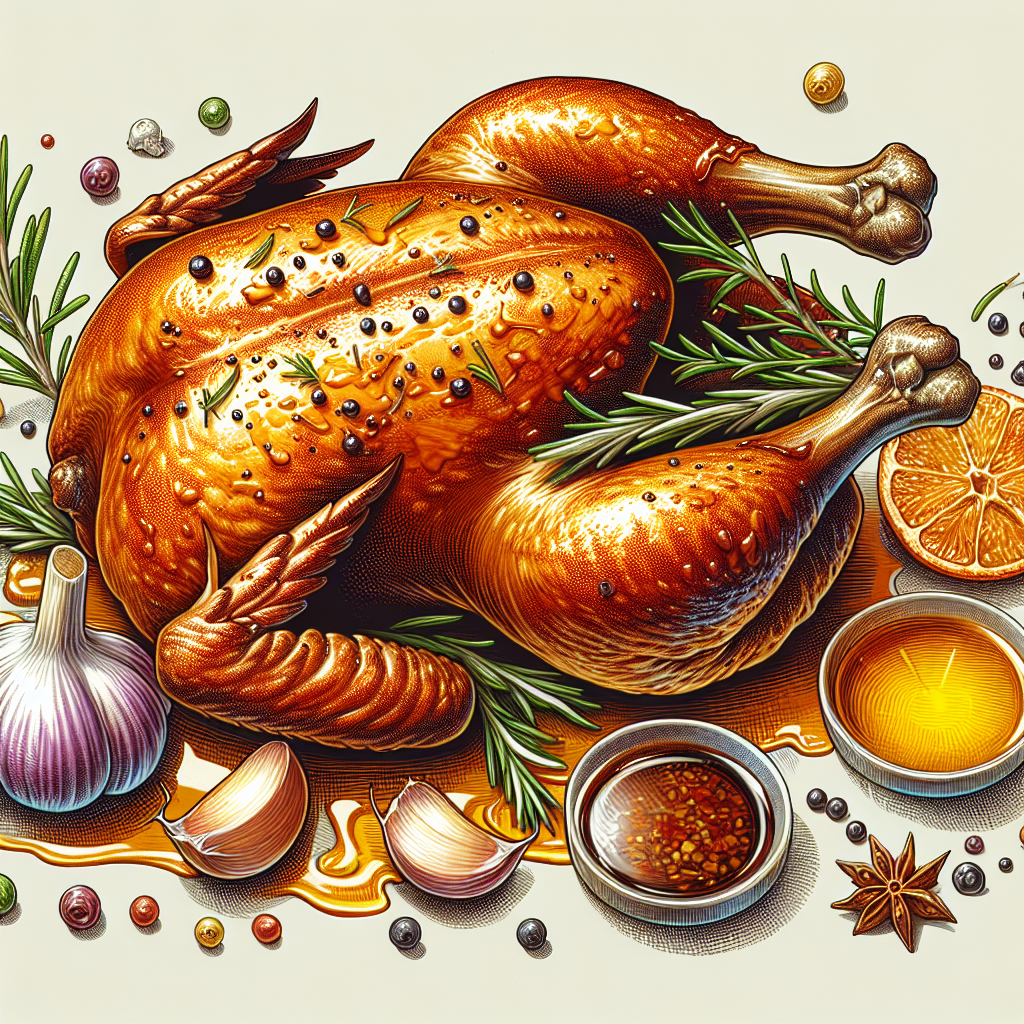In this informative article, you will uncover the fascinating science behind roasting and discover the key player in creating those enticing flavors – the Maillard reaction. As you embark on a journey to master the art of cooking, Tastepan’s expert cooking tips and techniques will equip you with the knowledge to perfect your roasting skills. From understanding the chemistry behind the Maillard reaction to learning how to achieve that perfect golden crust, this article is your gateway to becoming a true kitchen pro. Get ready to delve into the world of roasting and unlock the secrets that will elevate your culinary creations to new heights.

Understanding the Maillard Reaction
The Maillard Reaction is a complex chemical process that occurs between amino acids and reducing sugars when exposed to heat. Named after French chemist Louis-Camille Maillard, this reaction is responsible for the browning, flavor, and aroma development in a variety of cooked foods.
Definition
The Maillard Reaction can be defined as a non-enzymatic reaction between amino acids and reducing sugars, resulting in the formation of flavor compounds, browning of food, and the development of aromatic compounds. This reaction requires high heat and occurs primarily during cooking and baking processes.
Chemical Reactions Involved
The Maillard Reaction involves a series of complex chemical reactions between amino acids and reducing sugars. Primarily, it includes the condensation of carbonyl groups from reducing sugars with amino groups from amino acids, resulting in the formation of a variety of flavor compounds and brown pigments.
Role of Amino Acids
Amino acids play a crucial role in the Maillard Reaction. They are the building blocks of proteins and can be found in various food sources. During cooking, the amino acids undergo chemical transformations, resulting in the formation of volatile compounds that contribute to the flavor and aroma of the final dish.
Role of Reducing Sugars
Reducing sugars, such as glucose and fructose, are an essential component in the Maillard Reaction. They contain a carbonyl group that readily reacts with the amino acids. When exposed to heat, reducing sugars undergo a series of complex transformations, leading to the formation of a diverse range of flavor compounds and pigments.
Temperature and Time Factors
Temperature and time are critical factors that affect the Maillard Reaction. Higher temperatures can accelerate the reaction, leading to faster browning and flavor development. However, too high of a temperature can result in burnt or bitter flavors. The duration of cooking or baking also influences the Maillard Reaction, with longer cooking times allowing for more extensive flavor development.
Impact of the Maillard Reaction on Flavor
The Maillard Reaction has a significant impact on the flavor profile of cooked foods. It contributes to the creation of a wide range of flavor compounds that enhance the taste and aroma of dishes.
Formation of Flavor Compounds
During the Maillard Reaction, numerous flavor compounds are formed. These compounds include pyrazines, furans, and heterocyclic compounds, which give cooked foods their distinct savory, nutty, and roasted flavors. The complex interaction of amino acids and reducing sugars leads to the creation of a complex flavor profile that can elevate the taste of various dishes.
Role in Developing Aroma
Apart from flavor development, the Maillard Reaction also plays a vital role in the development of aroma in cooked foods. The volatile compounds produced during the reaction contribute to the enticing smells associated with roasted and baked goods. These aromas not only stimulate our senses but also enhance our overall dining experience.
Browning and Crust Formation
One of the visible effects of the Maillard Reaction is the browning and crust formation on the surface of cooked foods. This browning is a result of the formation of melanoidins, which are brown pigments produced during the Maillard Reaction. Browning not only adds visual appeal to dishes but also adds depth and complexity to their flavors.

The Maillard Reaction in Different Food Types
The Maillard Reaction occurs in a variety of food types, each contributing to distinctive flavors and textures. Understanding the role of the Maillard Reaction in different food categories allows for a deeper appreciation of culinary techniques.
Meat and Poultry
When meat and poultry are cooked, the Maillard Reaction plays a crucial role in developing their characteristic savory flavors and appealing brown crusts. The browning of the meat occurs due to the Maillard Reaction between the amino acids present in the meat and the reducing sugars in its surface. This reaction leads to the formation of new aromatic compounds, resulting in the delicious flavors we associate with well-cooked meats.
Bread and Baked Goods
In the world of baking, the Maillard Reaction is responsible for giving bread and baked goods their golden crusts and enticing aromas. When dough is exposed to high heat, the reaction occurs between the amino acids from the proteins in the flour and the reducing sugars present in the dough. This reaction not only contributes to the crust formation but also enhances the overall flavor and aroma of the baked goods.
Coffee and Roasted Beverages
The Maillard Reaction also plays a significant role in the production of roasted beverages, such as coffee and malted drinks. During the roasting process, the Maillard Reaction occurs between the amino acids and reducing sugars present in the coffee beans or malted grains, resulting in the development of their characteristic flavors and aromas. This reaction is crucial in bringing out the rich and complex tastes in our favorite cups of coffee.
Caramelization vs. Maillard Reaction
While often used interchangeably, caramelization and the Maillard Reaction are distinct processes. Caramelization involves the breakdown of sugars through heat alone, resulting in the formation of caramel flavors and colors. On the other hand, the Maillard Reaction entails the reaction between amino acids and reducing sugars, leading to the formation of a wide range of flavor compounds and brown pigments. Both processes contribute to the overall flavor complexity of cooked foods.
Controlling the Maillard Reaction
Controlling the Maillard Reaction is essential for achieving the desired flavors and colors in cooked dishes. Various factors can influence the rate and extent of the reaction, allowing chefs and home cooks to have greater control over their culinary creations.
Factors Affecting the Maillard Reaction
Several factors affect the Maillard Reaction, including temperature, pH, water activity, and the presence of catalysts. By adjusting these factors, it is possible to manipulate the Maillard Reaction to achieve different flavor profiles and textures in cooked foods.
Impact of pH and Water Activity
The pH level and water activity in a cooking environment can significantly influence the Maillard Reaction. Foods with a higher pH, such as alkaline ingredients, tend to undergo the Maillard Reaction more rapidly, resulting in faster browning and flavor development. On the other hand, adjusting the water activity, or moisture content, can affect the rate at which the reaction takes place. Lower water activity can promote the Maillard Reaction, while higher water activity may inhibit its progress.
Using Different Cooking Methods
The Maillard Reaction can be influenced by different cooking methods. For example, methods such as grilling and roasting expose food to high direct heat, promoting faster and more pronounced browning and Maillard Reaction. On the other hand, simmering or boiling may not produce the same depth of flavor and browning, as the temperatures are not high enough to fully activate the reaction.
Marination and Brining Techniques
Marination and brining techniques can also impact the Maillard Reaction. When meat or poultry is marinated or brined, the addition of acids or salt alters the pH and water activity, affecting the rate at which the Maillard Reaction occurs. These techniques help to enhance flavor, tenderness, and browning in the final dish.

Enhancing the Maillard Reaction
To maximize the flavors and aromas brought about by the Maillard Reaction, various techniques and ingredients can be employed.
Seasoning and Spices
Seasonings and spices can play a crucial role in enhancing the Maillard Reaction and adding complexity to the flavors. Ingredients like salt, black pepper, herbs, and spices not only add their own distinctive flavors but can also promote browning and enhance the overall taste of the dish.
Using Sugars and Glazes
Adding sugars and glazes to foods can enhance the Maillard Reaction. The presence of sugars increases the availability of reducing sugars, which can react with the amino acids more readily, resulting in a more robust Maillard Reaction. Glazes, such as honey or maple syrup, can provide an extra layer of sweetness and contribute to the browning and formation of flavor compounds.
Effect of Fat and Oil
Fat and oil play a vital role in developing the Maillard Reaction. When foods are cooked in oil or fat, they provide a medium for the Maillard Reaction to occur, facilitating better heat transfer and browning. Fat also adds richness to the flavor and can contribute to the overall taste of the dish.
Utilizing Maillard Reaction in Sauces and Gravies
The Maillard Reaction can be harnessed to create flavorful sauces and gravies. When deglazing the pan after cooking meat or vegetables, the browned bits left behind contain a treasure trove of flavor compounds resulting from the Maillard Reaction. By incorporating these browned bits, or fond, into sauces and gravies, one can elevate the dish’s flavor profile.
Common Misconceptions about the Maillard Reaction
Despite its importance in cooking, there are several misconceptions about the Maillard Reaction that often lead to confusion or misunderstanding.
Confusion with Caramelization
One common misconception is the confusion between the Maillard Reaction and caramelization. While both processes result in browning, they are distinct reactions with different chemical pathways. Caramelization involves the breakdown of sugars through heat alone, while the Maillard Reaction is a complex interaction between amino acids and reducing sugars.
Beliefs about Exterior Color Equalling Doneness
Another misconception is that the exterior color of cooked food is an accurate indicator of doneness. While the Maillard Reaction contributes to browning, it is not a reliable gauge for measuring the internal temperature or doneness of a dish. To ensure proper cooking, it is essential to use a thermometer to check the internal temperature of the food.
Health Concerns and Controversies
There have been concerns regarding the potential health risks associated with the Maillard Reaction, particularly in relation to the formation of acrylamide. Acrylamide is a chemical compound that forms during the Maillard Reaction at high temperatures. However, the potential health risks are still a subject of scientific study and debate. It is advisable to practice moderation and a balanced diet to minimize any potential risks.
Beyond the Maillard Reaction: Other Chemical Reactions in Roasting
While the Maillard Reaction is a crucial process in cooking, there are other chemical reactions that also contribute to the flavors and textures of roasted foods.
Oxidation and Oxidative Browning
Oxidation is a chemical reaction that occurs when foods are exposed to air. It leads to the development of oxidative browning, a reaction responsible for the color changes in fruits like apples or potatoes when exposed to air. This process, although different from the Maillard Reaction, can contribute to the overall flavor complexity of roasted foods.
Caramelization
Caramelization, as mentioned earlier, is a process that involves the breakdown of sugars through heat alone. It results in the formation of caramel flavors and colors, adding additional depth and sweetness to dishes.
Starch Gelatinization
Starch gelatinization is a process that occurs when starch granules absorb liquid and heat. This process is important in the production of many roasted and baked goods, as it contributes to the thickening and cohesiveness of sauces, gravies, and fillings.
Protein Denaturation
During roasting, proteins undergo denaturation, a process where the protein structure unfolds and reorganizes due to the application of heat. This process is key in achieving the desired texture and tenderness in roasted meats and other protein-rich foods.
Fats and Oils: Hydrolysis and Polymerization
Fats and oils can undergo hydrolysis and polymerization during roasting. Hydrolysis refers to the breakdown of fats into fatty acids and glycerol, leading to the development of distinctive flavors. Polymerization, on the other hand, occurs when individual fatty acid molecules combine, resulting in the formation of complex structures and contributing to the overall texture and flavor of roasted foods.
The Role of Temperature and Time
Temperature and time play a crucial role in the roasting process. Understanding heat transfer and how different foods respond to varying temperatures and cooking times is essential for achieving optimal results.
Understanding Heat Transfer
Heat transfer is the process by which heat is conducted, convected, or radiated from a heat source to the food being cooked. It is important to understand how heat is transferred during roasting to ensure even and thorough cooking.
Low and Slow vs. High Heat Methods
Different cooking methods employ varying temperatures and cooking times. Low and slow cooking methods, such as braising, utilize lower temperatures and longer cooking times to break down tough fibers and develop complex flavors. On the other hand, high heat methods, like broiling or searing, use intense heat for shorter periods to create a flavorful crust while maintaining the desired internal doneness.
Roasting Time Guidelines for Different Foods
The cooking time for roasted foods can vary depending on factors such as size, thickness, and desired doneness. It is important to follow guidelines and recipes to ensure that foods are cooked to the desired level, whether it be rare, medium, or well-done. Using a thermometer is an excellent way to accurately determine the doneness of foods, minimizing the risk of undercooking or overcooking.
Cooking Equipment and Techniques for Roasting
Choosing the right cooking equipment and employing suitable roasting techniques can greatly influence the outcome of roasted dishes.
Oven Roasting
Oven roasting is a popular method for roasting a wide variety of foods. Conventional ovens provide controlled heat that evenly cooks the food. Choosing the right oven temperature and using appropriate roasting pans or racks can help achieve the desired flavors and textures.
Grilling and Barbecuing
Grilling and barbecuing involve cooking food over an open flame or hot coals. This method imparts a distinctive smoky flavor to the food and is commonly used for grilling meats, vegetables, and seafood. Different grilling techniques, such as direct or indirect heat, can be employed to achieve specific results.
Pan Roasting
Pan roasting combines both stovetop and oven cooking methods. It involves initially searing the food in a hot pan to develop a flavorful crust and then transferring it to the oven for further cooking. This technique is ideal for meats that benefit from a crispy exterior and a tender interior.
Sous Vide and Roasting
Sous vide cooking involves vacuum-sealing food in a bag and cooking it in a precise temperature-controlled water bath. While sous vide is not strictly a roasting technique, it is often used as a preliminary step before finishing the food in a hot oven or on a grill. This method allows for precise control over the doneness and texture of the food.
Professional Tips and Tricks for Perfect Roasting
Professional chefs have honed their roasting techniques over years of experience. Here are some tips and tricks to ensure your roasting endeavors are a success.
Preheating and Resting
Preheating the oven or cooking equipment is essential for achieving even cooking and proper browning. This allows the food to start cooking immediately upon entering the oven or heat source. Resting the cooked food before carving or serving allows the juices to redistribute, resulting in a moist and flavorful final dish.
Using Thermometers for Doneness
Using a food thermometer is the most accurate way to determine the doneness of food. Different types of thermometers, such as instant-read or probe thermometers, can be handy tools in achieving the perfect temperature and doneness.
Basting and Bastings
Basting is the process of coating the surface of the food with sauces, marinades, or pan drippings while it is cooking. This helps to keep the food moist and adds additional flavor. Regular bastings can also contribute to the development of a flavorful crust.
Achieving Crispy Skin and Tenderness
When roasting poultry or other meats with skin, achieving a crispy and golden brown skin can greatly enhance the overall eating experience. To achieve this, it is important to ensure that the skin is dry before roasting, using high heat to crisp the skin, and allowing for adequate resting time to ensure tenderness.
Resting and Carving
Resting is an important step in the roasting process. Allowing the cooked food to rest for a few minutes before carving or serving ensures that the juices are distributed evenly, resulting in a more succulent and flavorful final product. When carving, it is essential to use sharp knives and proper carving techniques to ensure clean slices without tearing or shredding the meat.
In conclusion, understanding the Maillard Reaction and its impact on flavor is essential for any aspiring chef or home cook. By grasping the chemical reactions involved, the role of amino acids and reducing sugars, and the factors that control and enhance the Maillard Reaction, one can elevate their culinary creations to the next level. With knowledge of roasting techniques, the role of temperature and time, and the use of appropriate cooking equipment and methods, achieving delicious and perfectly roasted dishes is within reach. So, don your apron, fire up your oven or grill, and embark on a flavorful journey of roasting mastery. Let the Maillard Reaction be your guide to culinary excellence. Happy cooking!

